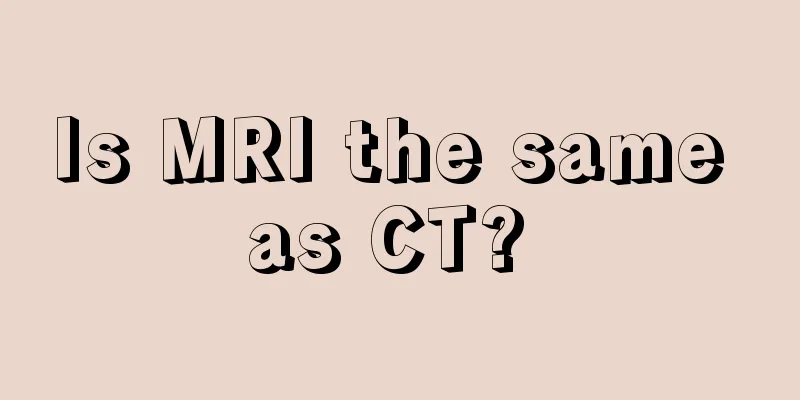Is MRI the same as CT?

|
The structure inside the human brain is extremely complex, and there are many diseases in the brain, such as the well-known cerebral congestion, brain abscess, and brain tumors. These diseases can cause similar symptoms in patients, such as dizziness and headache, etc. Therefore, in order to diagnose the disease, patients need to undergo scientific examinations, such as MRI examinations. So, is MRI the same as the CT examination that everyone often talks about? Is MRI the same as CT? MRI does little harm to the human body, while CT uses X-rays to examine the human body and produces radiation. Generally speaking, MRI tends to examine soft tissue, while CT tends to examine hard tissue (bone tissue). The examination should be based on specific circumstances. MRI has high soft tissue resolution, and MRI may be performed again if CT is not clear. If there is ferromagnetic metal in the body, it will affect MRI imaging, and if the metal moves in the body under the influence of the magnetic field, it will also cause damage to the human body. CT is a planar image (slice) of the human body, while MRI is a three-dimensional perspective image. If the location of the pathology cannot be confirmed, only MRI can be used. If it can be confirmed, CT will be enough. You cannot have an MRI if there are metal parts in your body. Just imagine the huge magnetic field. Anyway, the principle of CT is that the reflection time of X-rays is different to form an image. MRI is another major advancement in medical imaging after CT, so what is the difference between the two? MRI: It is water proton imaging, which uses an external magnetic field to change the spin direction of electrons around water protons, and then produces proton imaging based on this principle. So far, no clear harm of MRI examination to the human body has been found. CT: It is a density imaging. After X-rays penetrate the human body, due to the different densities of different tissues in the human body and different absorption rates of rays, an image with different density is produced through the post-processing system. The advantages are fast inspection speed and good density resolution, but the radiation is harmful to the human body. MRI examination precautions MRI examinations last a long time, are very sensitive to human movement, and are prone to artifacts, so they are not suitable for emergency and critically ill patients. During MRI scanning, the noise in the chamber is relatively high, so patients need to cooperate closely and remain calm. MRI, as a new imaging technology, will not affect human health, but six types of people are not suitable for MRI examination: 1. Even if you have a pacemaker installed; 2. People who have or are suspected of having metal foreign bodies in their eyes; 3. People who have undergone silver clip ligation for aneurysm; 4. People with metal foreign bodies or metal prostheses in their bodies; 5. Critically ill patients whose lives are in danger; 6. People with claustrophobia, etc. |
<<: What is the effect of standing for half an hour after a meal?
>>: What is the clinical significance of enhanced MRI?
Recommend
Dietary considerations after rectal polyp surgery
Many people around us have suffered from various ...
How to cure herpes quickly
Herpes is caused by the herpes virus, and there a...
What should I do if my aunt eats crabs
Women's menstrual period is a special period....
Sweat entering the eyes is harmful
Sweat is the liquid secreted by the skin on the b...
What Chinese medicine is good for kidney deficiency and liver fire?
A body with kidney deficiency will actually make ...
Upper teeth protrude and chin recedes
Many people's teeth are not perfect or straig...
5 typical symptoms of laryngeal cancer
The clinical manifestations of laryngeal cancer v...
Benefits of abdominal breathing
Breathing is an important process in our lives. C...
The harm of standing for a long time to women
The harm of standing for a long time to women wil...
What are the treatments for sensorineural hearing loss?
The ears are people's second pair of eyes. Th...
At what age does nasopharyngeal cancer usually develop? What are the late-stage symptoms?
At what age does nasopharyngeal cancer usually de...
Effects and contraindications of jujube
Jujube is a food we often eat. The nutritional va...
This is how to relieve the swelling of eyes after eyebrow surgery
Eyebrows play a key role in people's appearan...
Is it better to have more or less pubic hair?
In life, whether it is men or women, there will b...
Will breast cancer recur after five years of surgery?
Most patients believe that breast cancer will not...









